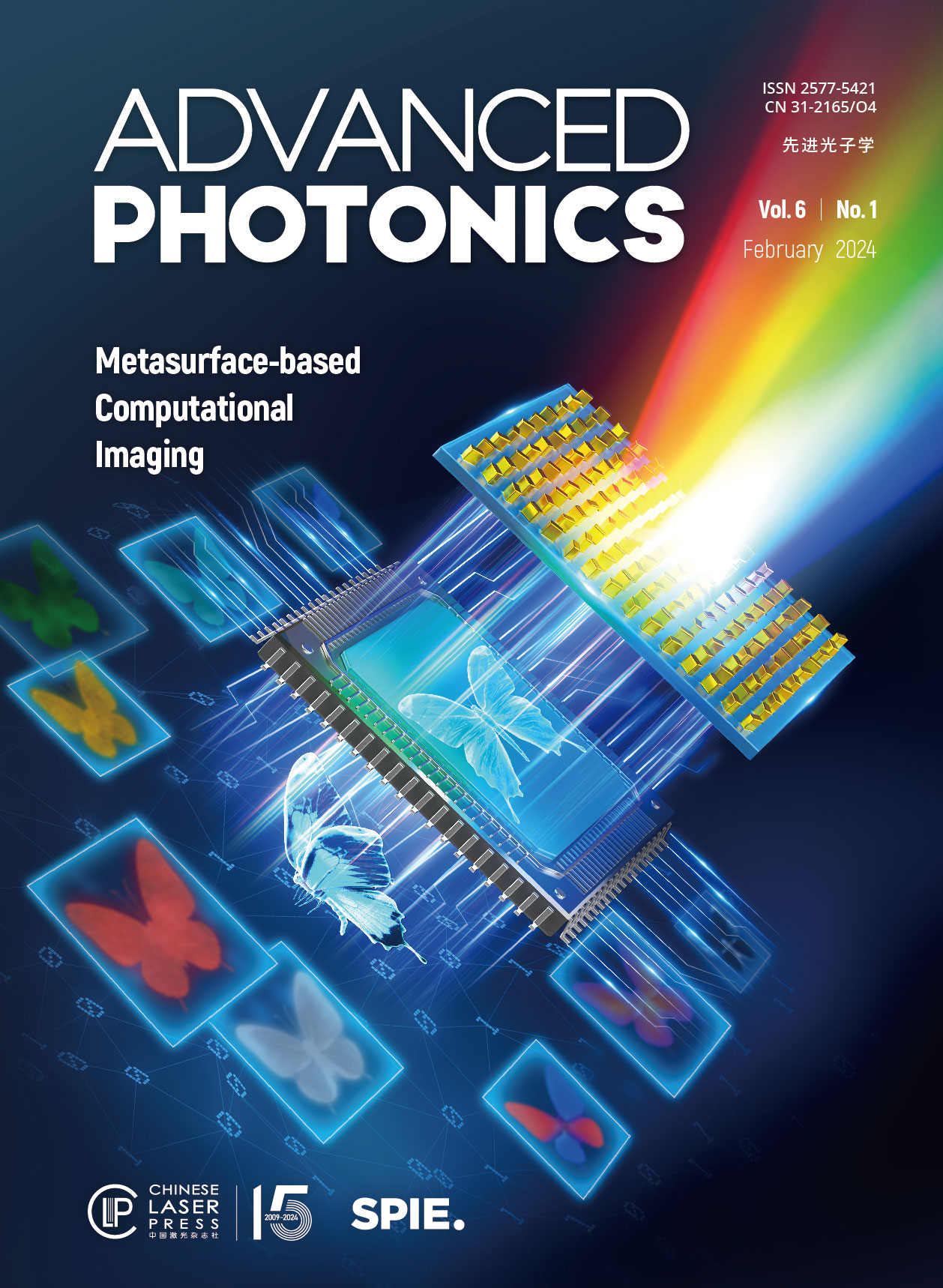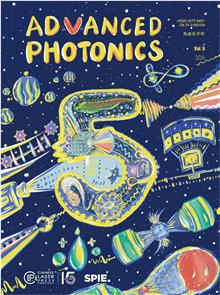 View fulltext
View fulltext
Featured on the cover is a schematic of a system utilizing metasurface-based optical modulation and computation. It modulates high-dimensional optical signals, encoding target information for tailored imaging tasks. Combined with co-optimized computational reconstruction, this approach ensures the high-quality recovery of diverse data types – hyperspectral, full-Stokes polarization, wavefront phase, or depth – depending on the specific imaging challenge.
The editorial remarks on the fifth anniversary of Advanced Photonics.
The article comments on a recent framework for all-optical classification using orbital-angular-momentum-encoded diffractive networks.
The article comments on recent work that provides theoretical underpinnings and experimental verification for modal power coupling in an air-core fiber, considering various types of modes.
Serge Haroche shares perspectives from his illustrious scientific career in physics and the evolving field of quantum photonics, in conversation with Chao-Yang Lu.
Being invisible ad libitum has long captivated the popular imagination, particularly in terms of safeguarding modern high-end instruments from potential threats. Decades ago, the advent of metamaterials and transformation optics sparked considerable interest in invisibility cloaks, which have been mainly demonstrated in ground and waveguide modalities. However, an omnidirectional flying cloak has not been achieved, primarily due to the challenges associated with dynamic synthesis of metasurface dispersion. We demonstrate an autonomous aeroamphibious invisibility cloak that incorporates a suite of perception, decision, and execution modules, capable of maintaining invisibility amidst kaleidoscopic backgrounds and neutralizing external stimuli. The physical breakthrough lies in the spatiotemporal modulation imparted on tunable metasurfaces to sculpt the scattering field in both space and frequency domains. To intelligently control the spatiotemporal metasurfaces, we introduce a stochastic-evolution learning that automatically aligns with the optimal solution through maximum probabilistic inference. In a fully self-driving experiment, we implement this concept on an unmanned drone and showcase adaptive invisibility in three canonical landscapes—sea, land, and air—with a similarity rate of up to 95%. Our work extends the family of invisibility cloaks to flying modality and inspires other research on material discoveries and homeostatic meta-devices.
The ever-increasing demand for training and inferring with larger machine-learning models requires more efficient hardware solutions due to limitations such as power dissipation and scalability. Optics is a promising contender for providing lower power computation, since light propagation through a nonabsorbing medium is a lossless operation. However, to carry out useful and efficient computations with light, generating and controlling nonlinearity optically is a necessity that is still elusive. Multimode fibers (MMFs) have been shown that they can provide nonlinear effects with microwatts of average power while maintaining parallelism and low loss. We propose an optical neural network architecture that performs nonlinear optical computation by controlling the propagation of ultrashort pulses in MMF by wavefront shaping. With a surrogate model, optimal sets of parameters are found to program this optical computer for different tasks with minimal utilization of an electronic computer. We show a remarkable decrease of 97% in the number of model parameters, which leads to an overall 99% digital operation reduction compared to an equivalently performing digital neural network. We further demonstrate that a fully optical implementation can also be performed with competitive accuracies.
Fluorescence confocal laser-scanning microscopy (LSM) is one of the most popular tools for life science research. This popularity is expected to grow thanks to single-photon array detectors tailored for LSM. These detectors offer unique single-photon spatiotemporal information, opening new perspectives for gentle and quantitative superresolution imaging. However, a flawless recording of this information poses significant challenges for the microscope data acquisition (DAQ) system. We present a DAQ module based on the digital frequency domain principle, able to record essential spatial and temporal features of photons. We use this module to extend the capabilities of established imaging techniques based on single-photon avalanche diode (SPAD) array detectors, such as fluorescence lifetime image scanning microscopy. Furthermore, we use the module to introduce a robust multispecies approach encoding the fluorophore excitation spectra in the time domain. Finally, we combine time-resolved stimulated emission depletion microscopy with image scanning microscopy, boosting spatial resolution. Our results demonstrate how a conventional fluorescence laser scanning microscope can transform into a simple, information-rich, superresolved imaging system with the simple addition of a SPAD array detector with a tailored data acquisition system. We expected a blooming of advanced single-photon imaging techniques, which effectively harness all the sample information encoded in each photon.
Efficient and precise photon-number-resolving detectors are essential for optical quantum information science. Despite this, very few detectors have been able to distinguish photon numbers with both high fidelity and a large dynamic range, all while maintaining high speed and high timing precision. Superconducting nanostrip-based detectors excel at counting single photons efficiently and rapidly, but face challenges in balancing dynamic range and fidelity. Here, we have pioneered the demonstration of 10 true photon-number resolution using a superconducting microstrip detector, with readout fidelity reaching an impressive 98% and 90% for 4-photon and 6-photon events, respectively. Furthermore, our proposed dual-channel timing setup drastically reduces the amount of data acquisition by 3 orders of magnitude, allowing for real-time photon-number readout. We then demonstrate the utility of our scheme by implementing a quantum random-number generator based on sampling the parity of a coherent state, which guarantees inherent unbiasedness, robustness against experimental imperfections and environmental noise, as well as invulnerability to eavesdropping. Our solution boasts high fidelity, a large dynamic range, and real-time characterization for photon-number resolution and simplicity with respect to device structure, fabrication, and readout, which may provide a promising avenue towards optical quantum information science.
Achieving spatiotemporal control of light at high speeds presents immense possibilities for various applications in communication, computation, metrology, and sensing. The integration of subwavelength metasurfaces and optical waveguides offers a promising approach to manipulate light across multiple degrees of freedom at high speed in compact photonic integrated circuit (PIC) devices. Here, we demonstrate a gigahertz-rate-switchable wavefront shaping by integrating metasurface, lithium niobate on insulator photonic waveguides, and electrodes within a PIC device. As proofs of concept, we showcase the generation of a focus beam with reconfigurable arbitrary polarizations, switchable focusing with lateral focal positions and focal length, orbital angular momentum light beams as well as Bessel beams. Our measurements indicate modulation speeds of up to the gigahertz rate. This integrated platform offers a versatile and efficient means of controlling the light field at high speed within a compact system, paving the way for potential applications in optical communication, computation, sensing, and imaging.
Spectroscopy is the basic tool for studying molecular physics and realizing biochemical sensing. However, it is challenging to realize sub-femtometer resolution spectroscopy over broad bandwidth. Broadband and high-resolution spectroscopy with calibrated optical frequency is demonstrated by bridging the fields of speckle pattern and electro-optic frequency comb. A wavemeter based on a whispering-gallery-mode barcode is proposed to link the frequencies of a probe continuous-wave laser and an ultrastable laser. The ultrafine electro-optic comb lines are generated from the probe laser to record spectrum of sample with sub-femtometer resolution. Measurement bandwidth is a thousandfold broader than comb bandwidth, by sequentially tuning the probe laser while its wavelength is determined. This approach fully exploits the advantages of two fields to realize 0.8-fm resolution with a fiber laser and 80-nm bandwidth with an external cavity diode laser. The spectroscopic measurements of an ultrahigh Q-factor cavity and gas molecular absorption are experimentally demonstrated. The compact system, predominantly constituted by few-gigahertz electronics and telecommunication components, shows enormous potential for practical spectroscopic applications.
Near-infrared (NIR) light has shown great potential for military and civilian applications owing to its advantages in the composition of sunlight, invisibility to human eyes, deeper penetration into biological tissues, and low optical loss in optical fibers. Therefore, organic optoelectronic materials that can absorb or emit NIR light have aroused great scientific interest in basic science and practical applications. Based on these NIR organic optoelectronic materials, NIR optoelectronic devices have been greatly improved in performance and application. In this review, the representative NIR organic optoelectronic materials used in organic solar cells, organic photodetectors, organic light-emitting diodes, organic lasers, and organic optical waveguide devices are briefly introduced, and the potential applications of each kind of device are briefly summarized. Finally, we summarize and take up the development of NIR organic optoelectronic materials and devices.
Metasurface-based imaging has attracted considerable attention owing to its compactness, multifunctionality, and subwavelength coding capability. With the integration of computational imaging techniques, researchers have actively explored the extended capabilities of metasurfaces, enabling a wide range of imaging methods. We present an overview of the recent progress in metasurface-based imaging techniques, focusing on the perspective of computational imaging. Specifically, we categorize and review existing metasurface-based imaging into three main groups, including (i) conventional metasurface design employing canonical methods, (ii) computation introduced independently in either the imaging process or postprocessing, and (iii) an end-to-end computation-optimized imaging system based upon metasurfaces. We highlight the advantages and challenges associated with each computational metasurface-based imaging technique and discuss the potential and future prospects of the computational boosted metaimager.














